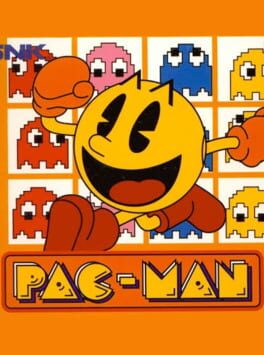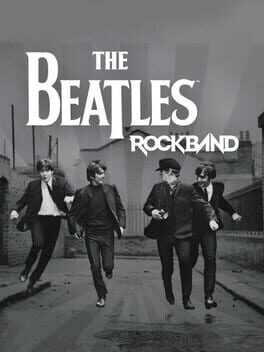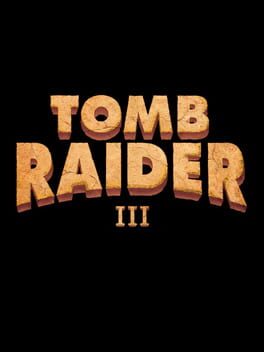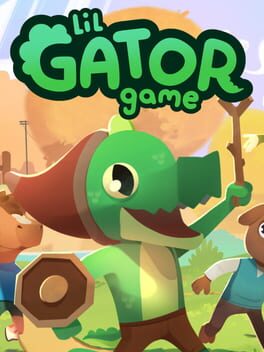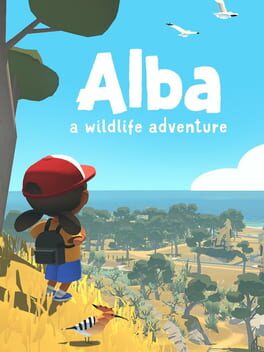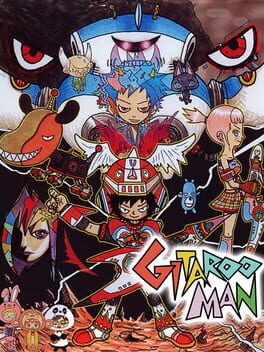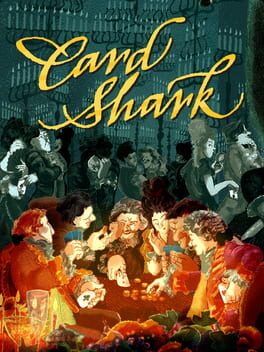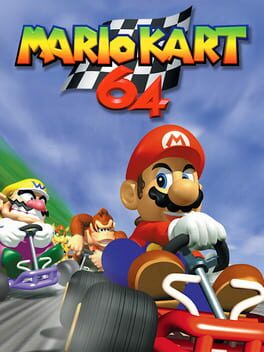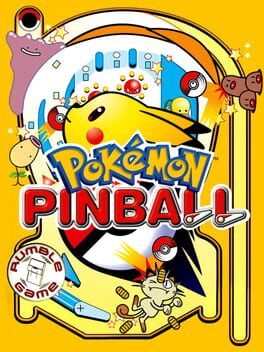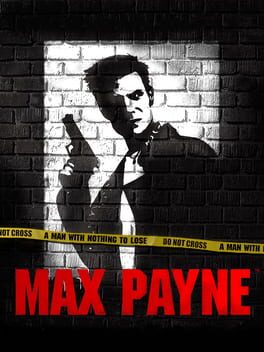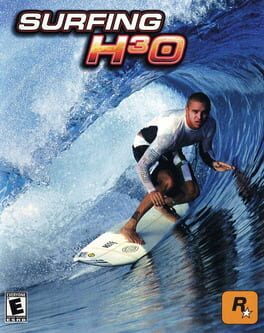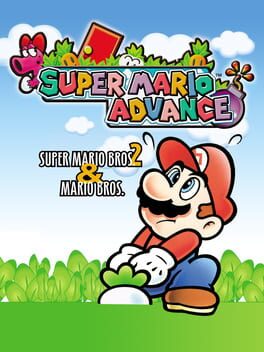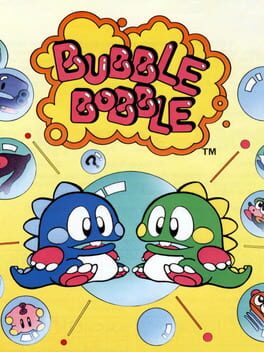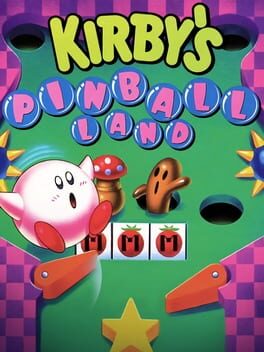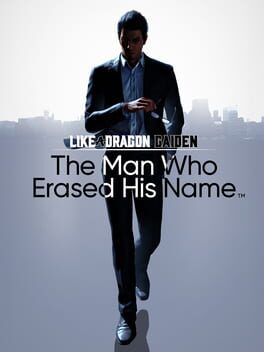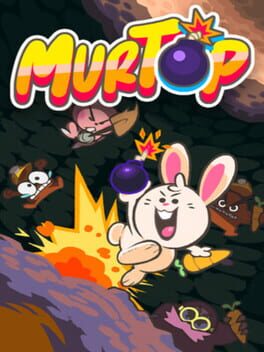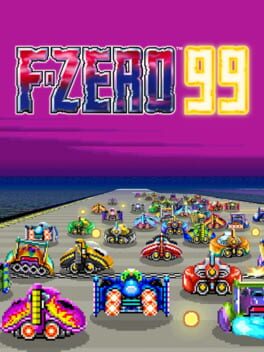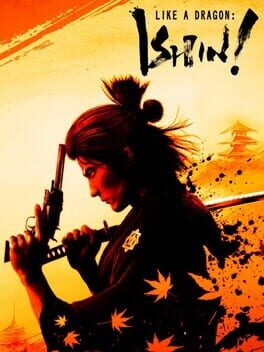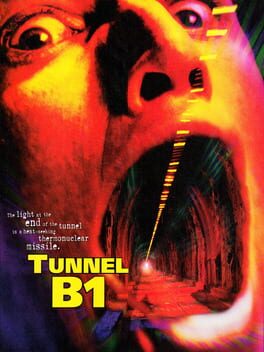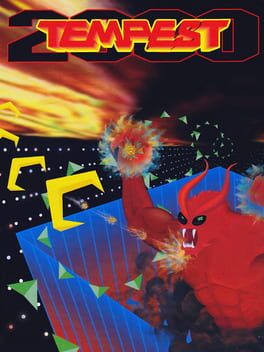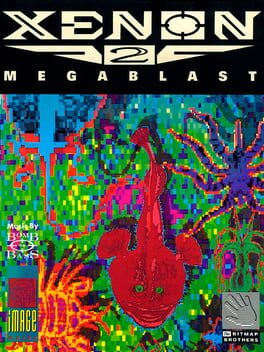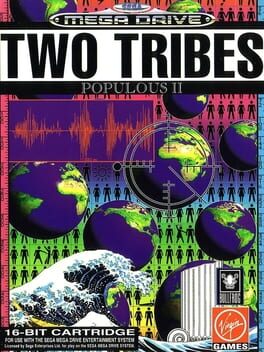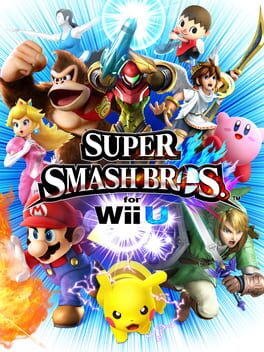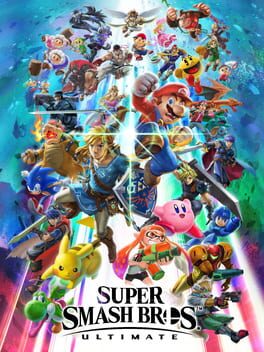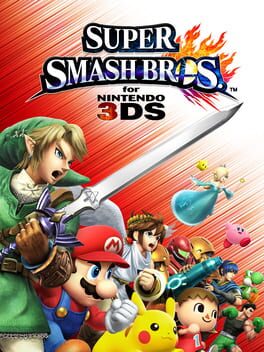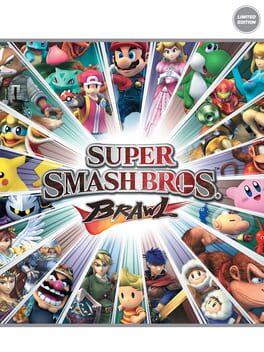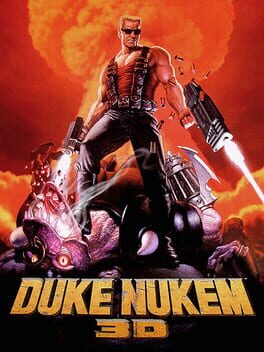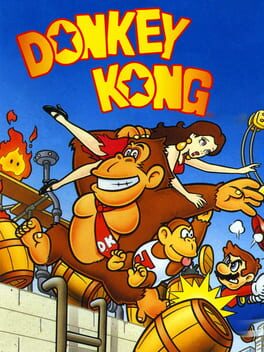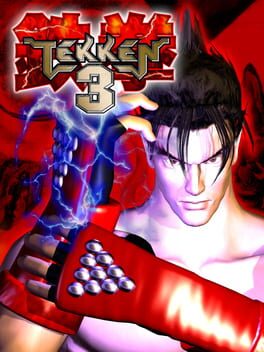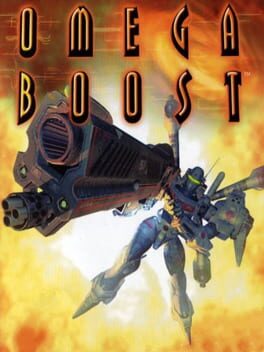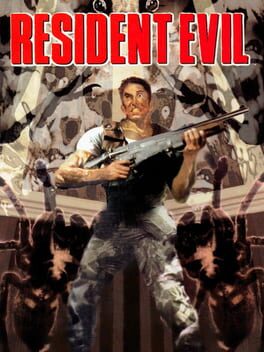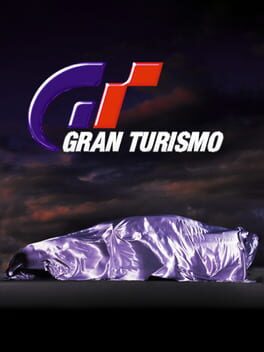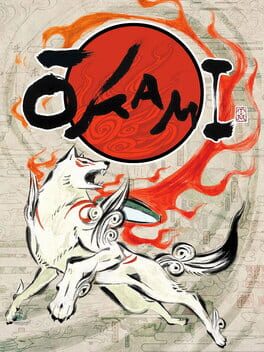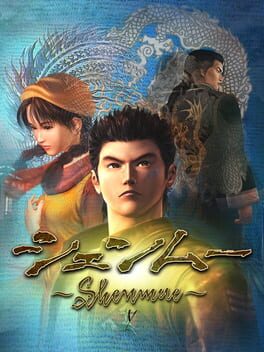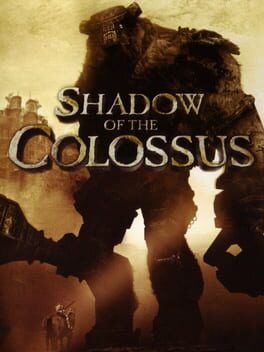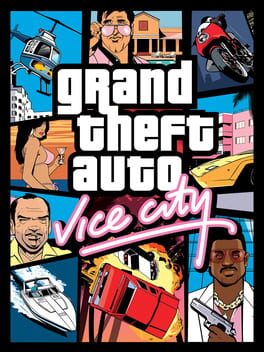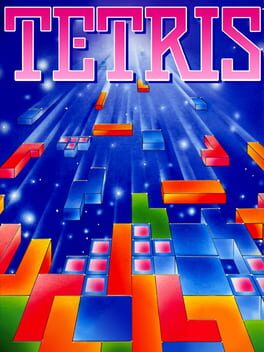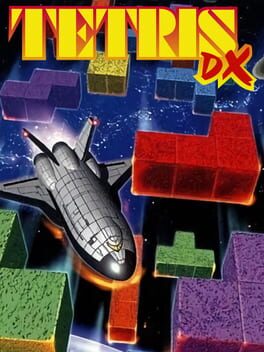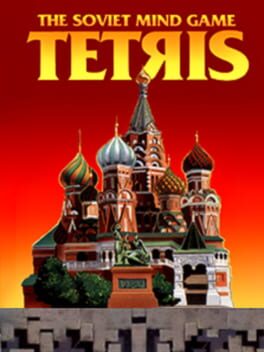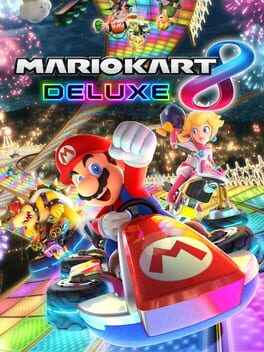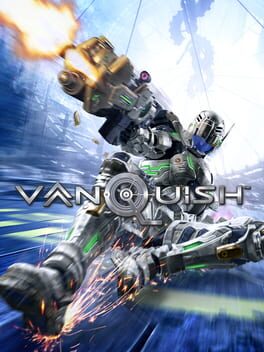Twan
289 reviews liked by Twan
Halo 3
2007
Pac-Man
1999
I recently purchased a "pack" of Oreo X PAC-MAN Limited Edition biscuits, and felt a tinge of impostor syndrome. Am I really a big enough Pac-Fan to eat these? I mean, sure, I can accurately identify Inky, Pinky, Blinky and Clyde no problem, and I know all the words to Buckner & Garcia's "Pac-Man Fever" off by heart - a song that rips the songwriting traditions of the blues out of the Mississippi Delta and righteously appropriates them to discuss the real hardships (being a gamer) - but I don't really rate Pac-Man as one of my favourite Namco games. It's almost a little too elemental. Too primal. It's a chase game, and that clearly had influence on personal favourites like Dig Dug and Metal Gear, but it doesn't have any of that Dig Dug or Metal Gear stuff that I like in it, either.
I can't decide whether releasing Pac-Man as a standalone Neo Geo Pocket Color game in 1999 was an act of extraordinary hubris, or an earned confidence. I mean, Super Mario Bros. Deluxe on the Game Boy Color was one thing, but this is fucking Pac-Man. No new modes or anything. Pac-Man. One step up from fucking Pong. Maybe if you're younger, all these 20th century years seem to blend together in a big "I don't care" grey area, but we were playing Quake III online by then (or at least, we'd heard someone's big brother did it once, but he had to get off the internet after one match because it was costing a fortune on the phone bill). Seeing this on the shelf below the Game Boys and Pokémon instantly lost all credibility SNK may have hoped to have gained with the under-20s crowd. In the 90's, "retro" was incredibly niche. Like, I was aware of the Street Fighter and Bubble Bobble collections on PS1, but when I imagined someone buying them, they were like studious historians, analysing the software like it had just been dug out of a pharaoh's tomb. These things weren't conceivable as "entertainment" for "people". Who the fuck bought this at launch?
Now, I am that decrepit auld bastard. NGPC Pac-Man is cool. A little obnoxiously so, actually. It kind of predicted the retro boom that would start to take hold in the following decade. Pac-Man is a gaming icon. Literally. He's probably the little button you press on your phone screen to get the emulators on. It's difficult to view him objectively as The Packing Man, unencumbered by the decades of cultural impact that followed, but having a little one-and-done cartridge like this helps.
NGPC Pac-Man's big feature is a little rubber ring that comes in the box. You attach it to the NGPC's microswitch stick and it blocks off the diagonal directions. It's actually really effective, and makes the game feel much snappier, as you're locked to 90 degree turns. SNK are an arcade developer, first and foremost, and their approach in designing a two-button handheld is actually really cute. I think if you're happy to go along with that, and not moan about how naive it is to use this strategy to compete with the Game Boy Color, it's super cool that they put Pac-Man on here. And they set aside some of the budget to manufacture a little piece of rubber to make it as satisfying as it ought to be.
Pac-Man is fun. It's immediately speedy. You don't even press a button, and you shoot right out of the gate. All you can do is steer, avoiding the ghosts, attempting to squeeze into a corner of the map that still has power pellets on it, and seeing if you can keep dodging the baddies long enough to clear the board. Each ghost has their own characteristic, and theoretically, you should be able to use this to determine which direction they'll take at a crossing, but I've still to take the lesson of which one's "Speedy" and which one's "Pokey" to heart. Even ignorant of the specific attributes, it adds something to the game, to know that they're each subtly distinct, and it's a fun dynamic to have in the background, as you do your best to survive.
If you've played enough 80s arcade games, you'll know that Pac-Man can be done very wrong. Have you ever played Wizard of Wor? Fuck me, man. What a nightmare. Pac-Man was pioneering. Most games of the time were either about fighting, sport, or attempting to rip-off Star Wars as liberally as Lucasfilm's legal representation would allow. Pac-Man wasn't trying to be something else. It was proud to be a videogame, and it did something that could only really take the form of a videogame. It was praised for its original, non-violent concept (eating ghosts is not in violation of the Geneva Convention, apparently). It didn't assume anything of its audience. It opened up videogames to entirely new players. Anybody could play this. All the Nintendo oldguard see Pac-Man as the gold standard, and Miyamoto's even pulled the strings, buddying up with Namco bigwigs, to get his own four-player fangame bundled in with copies of R: Racing Evolution. Without a strong affinity for videogames, Keita Takahashi signed up with Namco because they made stuff like Pac-Man, and what other business was committing themselves to fun, novel ideas like that? We all benefit from Pac-Man's glow, and we ought to respect him.
Will you play it for more than five minutes? Probably not. But that's okay, too. We need little games like this.
I can't decide whether releasing Pac-Man as a standalone Neo Geo Pocket Color game in 1999 was an act of extraordinary hubris, or an earned confidence. I mean, Super Mario Bros. Deluxe on the Game Boy Color was one thing, but this is fucking Pac-Man. No new modes or anything. Pac-Man. One step up from fucking Pong. Maybe if you're younger, all these 20th century years seem to blend together in a big "I don't care" grey area, but we were playing Quake III online by then (or at least, we'd heard someone's big brother did it once, but he had to get off the internet after one match because it was costing a fortune on the phone bill). Seeing this on the shelf below the Game Boys and Pokémon instantly lost all credibility SNK may have hoped to have gained with the under-20s crowd. In the 90's, "retro" was incredibly niche. Like, I was aware of the Street Fighter and Bubble Bobble collections on PS1, but when I imagined someone buying them, they were like studious historians, analysing the software like it had just been dug out of a pharaoh's tomb. These things weren't conceivable as "entertainment" for "people". Who the fuck bought this at launch?
Now, I am that decrepit auld bastard. NGPC Pac-Man is cool. A little obnoxiously so, actually. It kind of predicted the retro boom that would start to take hold in the following decade. Pac-Man is a gaming icon. Literally. He's probably the little button you press on your phone screen to get the emulators on. It's difficult to view him objectively as The Packing Man, unencumbered by the decades of cultural impact that followed, but having a little one-and-done cartridge like this helps.
NGPC Pac-Man's big feature is a little rubber ring that comes in the box. You attach it to the NGPC's microswitch stick and it blocks off the diagonal directions. It's actually really effective, and makes the game feel much snappier, as you're locked to 90 degree turns. SNK are an arcade developer, first and foremost, and their approach in designing a two-button handheld is actually really cute. I think if you're happy to go along with that, and not moan about how naive it is to use this strategy to compete with the Game Boy Color, it's super cool that they put Pac-Man on here. And they set aside some of the budget to manufacture a little piece of rubber to make it as satisfying as it ought to be.
Pac-Man is fun. It's immediately speedy. You don't even press a button, and you shoot right out of the gate. All you can do is steer, avoiding the ghosts, attempting to squeeze into a corner of the map that still has power pellets on it, and seeing if you can keep dodging the baddies long enough to clear the board. Each ghost has their own characteristic, and theoretically, you should be able to use this to determine which direction they'll take at a crossing, but I've still to take the lesson of which one's "Speedy" and which one's "Pokey" to heart. Even ignorant of the specific attributes, it adds something to the game, to know that they're each subtly distinct, and it's a fun dynamic to have in the background, as you do your best to survive.
If you've played enough 80s arcade games, you'll know that Pac-Man can be done very wrong. Have you ever played Wizard of Wor? Fuck me, man. What a nightmare. Pac-Man was pioneering. Most games of the time were either about fighting, sport, or attempting to rip-off Star Wars as liberally as Lucasfilm's legal representation would allow. Pac-Man wasn't trying to be something else. It was proud to be a videogame, and it did something that could only really take the form of a videogame. It was praised for its original, non-violent concept (eating ghosts is not in violation of the Geneva Convention, apparently). It didn't assume anything of its audience. It opened up videogames to entirely new players. Anybody could play this. All the Nintendo oldguard see Pac-Man as the gold standard, and Miyamoto's even pulled the strings, buddying up with Namco bigwigs, to get his own four-player fangame bundled in with copies of R: Racing Evolution. Without a strong affinity for videogames, Keita Takahashi signed up with Namco because they made stuff like Pac-Man, and what other business was committing themselves to fun, novel ideas like that? We all benefit from Pac-Man's glow, and we ought to respect him.
Will you play it for more than five minutes? Probably not. But that's okay, too. We need little games like this.
You never really hear about PS3 homebrew, do you? After hacking my PS3, I found out why. It's a fucking pain in the arse.
If you know where to look, and join a private discord, you can find people modding old PS3 games. I almost found myself motivated to pursue this when I found out that fans have brought back MGS4's online mode, but that didn't feel like something I needed. Apparently, having the whole of Revolver and Magical Mystery Tour as Rock Band DLC was.
I guess it speaks to how earnestly I love The Beatles. They weren't just a bunch of guys who played good songs. When they emerged out of the early sixties, they were like a whole new kind of person. They broke the conventions of what an adult was supposed to be, and with their wit, intelligence and compassion, made all those guys look ridiculous. They made it okay not to live for the expectations of society or your family name, but your passions. Maybe you're not a fan of the band personally, and that's fine, but I think if you have any interest in pop media, fringe political thought or the embrace of foreign cultures, I think you owe some gratitude to The Beatles' influence. I can't imagine there would be a videogame industry without The Fabs. (This is beside the point, but did you know all those Atari 2600 cover artists were Yellow Submarine animators?)
Playing PS3 Rock Band in 2024 at all is a pain in the arse. If you didn't buy all the equipment 15 years ago, and held onto them for the following decade and a half, you have some very expensive eBay purchases ahead of you if you want to get in on this. I've still got a couple of the guitars, but thanks to multiple house moves, and weird, malicious flatmates who may not have appreciated my vocals on Debaser, those USB dongles were long gone. And it's not as if you can just buy any old dongle. With very few exceptions, they will only pair with their specific controller. And I have one of those fancy George Harrison Gretsch Duo Jets that you couldn't even buy in highstreet shops. I'm not willing to readily give up how much I spent on the dongle when it finally showed up for sale. Unless you're emulating (and seriously, if you're new to all this, please consider emulating), there's no new devices that are compatible with the PS3 games. Harmonix remedied this a little bit with the release of Rock Band 4, which supported full song exports for the previous games (which require DLC keys that are no longer purchasable) and are still playable on PS5 and Xbox Series consoles today, but one-off games like The Beatles Rock Band, which didn't allow you to transfer their highly-valued content to other titles, are still trapped on PS3, Wii and 360, with all their awkward "it made sense at the time" quirks.
So, hacking. I'm not confident I can recall the process well enough to provide even the most rudimentary of tutorials, but if you're going to hack your PS3, you'll need to be on a specific outdated firmware release, and it matters what kind of PS3 you have. You can utilise custom firmware on original PS3s and some slim models, but if, like me, you currently own a "superslim", you'll have more limited access to homebrew software. You can still do it though, with the Homebrew Enabler software ("PS3HEN"), but it's just a little more awkward. Each custom song needs to be transferred to the PS3 via FTP software (something that the installation guidelines only give a cursory mention of, and I hadn't used since college), you may need to make a direct Ethernet connection between your computer and PS3, and you'll need to keep every track in a special folder on your PC to use an executable to recompile the full tracklist each time you want to modify it. You also have to transfer over a special bit of software to make the game modifiable in the first place, and in the haze of everything I tried and retried, I really can't remember how I did this. This isn't a casual undertaking.
I'd argue Harmonix are one of the most under-valued development studios out there. Even in their smaller games, like Super Beat Sports, that nobody cares about, they're stuffed to the brim with extra modes and optional content. Rock Band was an insane logistical undertaking. Not only are thousands of songs accurately transcribed for multiple instruments and difficulty settings, but the on-stage bands are authentically animated, too. They made enormous bespoke electric drumkit controllers and sold them to American normies. By the peak of all their energy and ambition, on Rock Band 3, they were even including tracks for two backing vocalists, "Pro Guitar" mode (which would have you plug in either a midi-compatible electric guitar or a special, expensive plastic one with buttons on every string of every fret, to play the real guitar parts) and keytar, and barely anybody was playing the game like that. That doesn't even scratch the surface of how much of an undertaking it was to acquire the licences to an incredible range of pop and rock songs from a huge number of different publishing houses, and re-sell them. Of course, modders don't have to worry about the legal aspect, but it's just as ambitious for them to attempt reverse engineering the game to play home-made content and match the level of quality that Harmonix established.
There are amateurish custom Beatles Rock Band DLC tracks out there, but they're not the ones made by the core TBRB Customs devs. For the most part, you'd really struggle to tell them apart from the official Harmonix ones without prior knowledge. Sure, they have to lean on the handful of environments that were established for the original game, some of the surreal Pepperland visuals wear a little thin when applied to multiple songs, and in a post-Get Back world, Twickenham and Apple Studios seem like crucial Beatle locations, so it's a shame that they haven't been incorporated, but man, they managed to hack the Magical Mystery Tour bus into this. Would you have even the slightest idea how to make your PS3 games do that? They've been pretty clever, utilising the established assets to animate each new song, and the multiple costume changes during Glass Onion's callbacks are a particular treat.
TBRB Customs have set themselves the goal of creating custom DLC for every studio-recorded Beatles album, including the Past Masters singles collections and Giles Martin's remix album, Love. It's a lofty ambition, and the team have approached the to-do list with a completionist mindset. Frustratingly, this means that many of the most wanted tracks have been held off on for now, while we're stuck pissing around for the files for Sie Leibt Dich and Hold Me Tight. So far, there's been a huge number of tracks from With The Beatles and A Hard Day's Night, but no All I've Got To Do or You Can't Do That, and I personally find that extremely distressing. No Baby's In Black, no Hide Your Love Away, no Bad Boy, upsettingly few White Album songs - we're promised them in the future, but apparently, there were no new releases in the whole of 2023, and the team's recent focus has been on making previous tracks available for the Wii version of the game. I really want to believe they'll complete the tracklist, but I worry their energy may run dry when they see how many years they'll need to devote to the process.
There's also the fact that the modders seem to be young American Beatles fans. The kind who cried over 2023's Now & Then and think all of Paul McCartney's solo career is worth paying attention to. They don't have the same interest in the back catalogue as us slightly older fans who still think John was the big Beatle to like, despite the things he's alleged to have done after hearing of Nixon's reelection. They're insular and memey, and if you look into the more amateurish Anthology and Solo Career projects, you'll have to wade through some rake of Spongebob shit to get some comparatively rough content. It's very annoying that they've made a custom track for George's terrible White Album off-cut, Circles, while we're still waiting for Happiness is a Warm Gun, but I shouldn't upset the babies too much while they're working so diligently on my precious Rock Band DLC.
There's always a bit of a fear of custom Rock Band stuff. The most hardcore fans seem to be those who never got over Through the Fire and Flames, and not just guys who really like songs. While the focus in this DLC has been on matching Harmonix's precedent, there's still a wee bit of that Guitar Hero elite in here. We were never supposed to play the tape loop at the end of Strawberry Fields Forever, and I think you know this. Please take your job more seriously, unpaid hobbyists.
Many have approached the custom content as a thing strictly for emulators, and sensibly, it's the only way I can recommend a fan to go through this rigmarole. That strips out so much of Rock Band's appeal for me, though. For me, accessibility was such a draw to these games. I've played them at house parties with exchange students who really struggled with conversational English, but were delighted to see those falling note icons and become part of the band. If fellow Big Bad Beatleborgs are over, I can show them my special game that has twice as many songs as anybody else's copy, and we can delight in playing the whole of the Long Tall Sally EP. Nobody should go through the embarrassment of having to navigate a docked Steam Deck in front of another person. Now I've got everything set up, Beatles Rock Band is just as inviting to casuals as it was in 2009. I can grumble about minor details or the trajectory of the project, but really, it's so cool that any of this is possible.
If you know where to look, and join a private discord, you can find people modding old PS3 games. I almost found myself motivated to pursue this when I found out that fans have brought back MGS4's online mode, but that didn't feel like something I needed. Apparently, having the whole of Revolver and Magical Mystery Tour as Rock Band DLC was.
I guess it speaks to how earnestly I love The Beatles. They weren't just a bunch of guys who played good songs. When they emerged out of the early sixties, they were like a whole new kind of person. They broke the conventions of what an adult was supposed to be, and with their wit, intelligence and compassion, made all those guys look ridiculous. They made it okay not to live for the expectations of society or your family name, but your passions. Maybe you're not a fan of the band personally, and that's fine, but I think if you have any interest in pop media, fringe political thought or the embrace of foreign cultures, I think you owe some gratitude to The Beatles' influence. I can't imagine there would be a videogame industry without The Fabs. (This is beside the point, but did you know all those Atari 2600 cover artists were Yellow Submarine animators?)
Playing PS3 Rock Band in 2024 at all is a pain in the arse. If you didn't buy all the equipment 15 years ago, and held onto them for the following decade and a half, you have some very expensive eBay purchases ahead of you if you want to get in on this. I've still got a couple of the guitars, but thanks to multiple house moves, and weird, malicious flatmates who may not have appreciated my vocals on Debaser, those USB dongles were long gone. And it's not as if you can just buy any old dongle. With very few exceptions, they will only pair with their specific controller. And I have one of those fancy George Harrison Gretsch Duo Jets that you couldn't even buy in highstreet shops. I'm not willing to readily give up how much I spent on the dongle when it finally showed up for sale. Unless you're emulating (and seriously, if you're new to all this, please consider emulating), there's no new devices that are compatible with the PS3 games. Harmonix remedied this a little bit with the release of Rock Band 4, which supported full song exports for the previous games (which require DLC keys that are no longer purchasable) and are still playable on PS5 and Xbox Series consoles today, but one-off games like The Beatles Rock Band, which didn't allow you to transfer their highly-valued content to other titles, are still trapped on PS3, Wii and 360, with all their awkward "it made sense at the time" quirks.
So, hacking. I'm not confident I can recall the process well enough to provide even the most rudimentary of tutorials, but if you're going to hack your PS3, you'll need to be on a specific outdated firmware release, and it matters what kind of PS3 you have. You can utilise custom firmware on original PS3s and some slim models, but if, like me, you currently own a "superslim", you'll have more limited access to homebrew software. You can still do it though, with the Homebrew Enabler software ("PS3HEN"), but it's just a little more awkward. Each custom song needs to be transferred to the PS3 via FTP software (something that the installation guidelines only give a cursory mention of, and I hadn't used since college), you may need to make a direct Ethernet connection between your computer and PS3, and you'll need to keep every track in a special folder on your PC to use an executable to recompile the full tracklist each time you want to modify it. You also have to transfer over a special bit of software to make the game modifiable in the first place, and in the haze of everything I tried and retried, I really can't remember how I did this. This isn't a casual undertaking.
I'd argue Harmonix are one of the most under-valued development studios out there. Even in their smaller games, like Super Beat Sports, that nobody cares about, they're stuffed to the brim with extra modes and optional content. Rock Band was an insane logistical undertaking. Not only are thousands of songs accurately transcribed for multiple instruments and difficulty settings, but the on-stage bands are authentically animated, too. They made enormous bespoke electric drumkit controllers and sold them to American normies. By the peak of all their energy and ambition, on Rock Band 3, they were even including tracks for two backing vocalists, "Pro Guitar" mode (which would have you plug in either a midi-compatible electric guitar or a special, expensive plastic one with buttons on every string of every fret, to play the real guitar parts) and keytar, and barely anybody was playing the game like that. That doesn't even scratch the surface of how much of an undertaking it was to acquire the licences to an incredible range of pop and rock songs from a huge number of different publishing houses, and re-sell them. Of course, modders don't have to worry about the legal aspect, but it's just as ambitious for them to attempt reverse engineering the game to play home-made content and match the level of quality that Harmonix established.
There are amateurish custom Beatles Rock Band DLC tracks out there, but they're not the ones made by the core TBRB Customs devs. For the most part, you'd really struggle to tell them apart from the official Harmonix ones without prior knowledge. Sure, they have to lean on the handful of environments that were established for the original game, some of the surreal Pepperland visuals wear a little thin when applied to multiple songs, and in a post-Get Back world, Twickenham and Apple Studios seem like crucial Beatle locations, so it's a shame that they haven't been incorporated, but man, they managed to hack the Magical Mystery Tour bus into this. Would you have even the slightest idea how to make your PS3 games do that? They've been pretty clever, utilising the established assets to animate each new song, and the multiple costume changes during Glass Onion's callbacks are a particular treat.
TBRB Customs have set themselves the goal of creating custom DLC for every studio-recorded Beatles album, including the Past Masters singles collections and Giles Martin's remix album, Love. It's a lofty ambition, and the team have approached the to-do list with a completionist mindset. Frustratingly, this means that many of the most wanted tracks have been held off on for now, while we're stuck pissing around for the files for Sie Leibt Dich and Hold Me Tight. So far, there's been a huge number of tracks from With The Beatles and A Hard Day's Night, but no All I've Got To Do or You Can't Do That, and I personally find that extremely distressing. No Baby's In Black, no Hide Your Love Away, no Bad Boy, upsettingly few White Album songs - we're promised them in the future, but apparently, there were no new releases in the whole of 2023, and the team's recent focus has been on making previous tracks available for the Wii version of the game. I really want to believe they'll complete the tracklist, but I worry their energy may run dry when they see how many years they'll need to devote to the process.
There's also the fact that the modders seem to be young American Beatles fans. The kind who cried over 2023's Now & Then and think all of Paul McCartney's solo career is worth paying attention to. They don't have the same interest in the back catalogue as us slightly older fans who still think John was the big Beatle to like, despite the things he's alleged to have done after hearing of Nixon's reelection. They're insular and memey, and if you look into the more amateurish Anthology and Solo Career projects, you'll have to wade through some rake of Spongebob shit to get some comparatively rough content. It's very annoying that they've made a custom track for George's terrible White Album off-cut, Circles, while we're still waiting for Happiness is a Warm Gun, but I shouldn't upset the babies too much while they're working so diligently on my precious Rock Band DLC.
There's always a bit of a fear of custom Rock Band stuff. The most hardcore fans seem to be those who never got over Through the Fire and Flames, and not just guys who really like songs. While the focus in this DLC has been on matching Harmonix's precedent, there's still a wee bit of that Guitar Hero elite in here. We were never supposed to play the tape loop at the end of Strawberry Fields Forever, and I think you know this. Please take your job more seriously, unpaid hobbyists.
Many have approached the custom content as a thing strictly for emulators, and sensibly, it's the only way I can recommend a fan to go through this rigmarole. That strips out so much of Rock Band's appeal for me, though. For me, accessibility was such a draw to these games. I've played them at house parties with exchange students who really struggled with conversational English, but were delighted to see those falling note icons and become part of the band. If fellow Big Bad Beatleborgs are over, I can show them my special game that has twice as many songs as anybody else's copy, and we can delight in playing the whole of the Long Tall Sally EP. Nobody should go through the embarrassment of having to navigate a docked Steam Deck in front of another person. Now I've got everything set up, Beatles Rock Band is just as inviting to casuals as it was in 2009. I can grumble about minor details or the trajectory of the project, but really, it's so cool that any of this is possible.
Tomb Raider III
2024
Never again. I refuse to beleive anybody has ever finished those London levels without a walkthrough. Or the last boss for that matter.
What a flawed, brutal clusterfuck of a sequel. It has some of the best art, locales and music of the series, but it’s also a meandering pain in the arse. It’s full of fuck you moments and poor level design that at best frustrate and at worst full on block your progress.
Kayaks can piss off. Super dark swimming levels can piss off. And so can Aldwych station. A thousand times over.
Still, delighted to have seen it through - even if i did have to use a walkthrough way more than I’d like to have done.
The worst of the trilogy following a 9 for TR1 and a forgiving 8 for TR2.
Now remaster Last Revelation.
What a flawed, brutal clusterfuck of a sequel. It has some of the best art, locales and music of the series, but it’s also a meandering pain in the arse. It’s full of fuck you moments and poor level design that at best frustrate and at worst full on block your progress.
Kayaks can piss off. Super dark swimming levels can piss off. And so can Aldwych station. A thousand times over.
Still, delighted to have seen it through - even if i did have to use a walkthrough way more than I’d like to have done.
The worst of the trilogy following a 9 for TR1 and a forgiving 8 for TR2.
Now remaster Last Revelation.
Emeraldia
1993
I feel a little sorry for Emeraldia. There's potential here, but it doesn't seem like the team really thought about what they were doing. I mean, this is a 1993 Namco puzzle game that they didn't bother porting to the Super Famicom. Can you think of a more damning indictment?
Emeraldia is a fairly typical-looking block-stacking puzzle game, but holy shit is it cute. These are some of the most lovable sprites I've ever seen. Though the gameplay only involves guiding falling blocks around the screen, Adventure Mode insists you're playing as a brave little dolphin called Mint, out to rescue his sea creature friends from the devil of the ocean, Jamir. The game looks really inviting, and the screen's constantly filled with messages from friendly fish, explaining the game to passing observers in the arcade, but it really feels too technical for its own good.
Blocks come down in L-shaped sets of three colours. If you match two colours by dropping them directly on top of each other, they'll both shatter, and later, break. If they're placed in an unbroken horizontal or diagonal line, you can use them for a chain reaction. Having blocks fall down in three parts at a time means you'll need to rely on chain reactions to earn more screen space. It can be a disarmingly tricky game, as each new block with a desirable colour will force another two unwanted colours on you too, and each placement feels like something of a compromise, but I find I do best when I play it like Puyo Puyo or Puzzle Fighter - attempting to assemble groups of colours without breaking them, in the hope they'll cause a big combo later down the line.
Emeraldia is split up into Normal Mode, Adventure Mode and Head-to-Head Play Mode. Despite the names, I think Adventure Mode seems much more like the main mode of the game. In it, you play through pre-made puzzle levels and attempt to free fish, trapped within the blocks. It's the cutest mode, with the most sense of character, and little story boxes every now and then. When you save a fish, there's a little digitised voiceclip that says "Thank you!". It's undoubtedly the mode that new players will want to try when they first come across an Emeraldia cabinet, but Mint's there on the main menu, recommending you start with Normal Mode. This strips out all sense of character that the game has, and just becomes an abstract block-stacking survival puzzle. You play until you fail, and there's no reward other than the potential to place on the high score screen, but it's the most direct way to understand the fundamentals and balance of the game. Then, there's Head-to-Head, which is just a 2-player versus mode with no option to play against a CPU. Despite how relatively small a part of the game Head-to-Head is, it defines the whole of the rest of the game, as you play everything in a little window to the left-hand side of the screen, with the right reserved for Player 2, who plays as a pink dolphin. I imagine a lot of players came to try for the first time, jumped into the two-player, didn't really know what they were doing, and walked away dissatisfied, looking for something that was actually fun.
That's the shame with this. I think there's an interesting puzzle dynamic in here, but it's badly framed. I didn't really know what I was doing until several levels into Adventure Mode, and I only made it that far because I was playing an Arcade Archives release that I'd already paid for, and the continues were free. Even now, I don't feel like a particularly good Emeraldia player. I think a really cute puzzle game ought to have very easily understood rules. Yes, I think they should be something like Puzzle Bobble. Puyo Puyo is a bit borderline, but it still seems a little aged-up from this, and you can make it through a few early levels without understanding the deeper strategies. Emeraldia looks like a game for the world's sweetest babies, but feels crueller than the puzzle game they made under the totalitarian rule of the Soviet Union. I don't think they really structured the game modes very well. There likely ought to be a mode that you play against the computer, as your dolphin reacts with funny animations in the side of the screen. I think the game came together best in Adventure Mode's last level, where we're told Mint is escaping from a crumbling cave with his fellow dolphin hostages. You start with a blank screen, but dolphins descend as part of the blocks, and you need to place them carefully to free them as quickly as possible. Why is that just one level, and not a full mode? Why do I have to play the whole story mode to get to the part with the most compelling gameplay hook?
Emeraldia's aesthetic tells one story, while its gameplay tells another. I don't think they necessarily needed to make this more simple and accessible, either. I could see this gaining an audience of hardened puzzle champions if they drew very dull, dry graphics for it, but then, they probably should have put a little more thought into its modes, too. I have sympathy for the developers. 1993 was a hideously busy time for Namco, and I don't think they really gave a shit about Emeraldia while they were focused on launching Ridge Racer, Cyber Sled and Air Combat. There wasn't any time to revise what they'd already made. It was sent into arcades to die in a dusty corner while visitors lost their minds over their first experiences with 3D. I'm very sorry. I think there's something here, and I really like Mint. I just wish they made his game better.
Emeraldia is a fairly typical-looking block-stacking puzzle game, but holy shit is it cute. These are some of the most lovable sprites I've ever seen. Though the gameplay only involves guiding falling blocks around the screen, Adventure Mode insists you're playing as a brave little dolphin called Mint, out to rescue his sea creature friends from the devil of the ocean, Jamir. The game looks really inviting, and the screen's constantly filled with messages from friendly fish, explaining the game to passing observers in the arcade, but it really feels too technical for its own good.
Blocks come down in L-shaped sets of three colours. If you match two colours by dropping them directly on top of each other, they'll both shatter, and later, break. If they're placed in an unbroken horizontal or diagonal line, you can use them for a chain reaction. Having blocks fall down in three parts at a time means you'll need to rely on chain reactions to earn more screen space. It can be a disarmingly tricky game, as each new block with a desirable colour will force another two unwanted colours on you too, and each placement feels like something of a compromise, but I find I do best when I play it like Puyo Puyo or Puzzle Fighter - attempting to assemble groups of colours without breaking them, in the hope they'll cause a big combo later down the line.
Emeraldia is split up into Normal Mode, Adventure Mode and Head-to-Head Play Mode. Despite the names, I think Adventure Mode seems much more like the main mode of the game. In it, you play through pre-made puzzle levels and attempt to free fish, trapped within the blocks. It's the cutest mode, with the most sense of character, and little story boxes every now and then. When you save a fish, there's a little digitised voiceclip that says "Thank you!". It's undoubtedly the mode that new players will want to try when they first come across an Emeraldia cabinet, but Mint's there on the main menu, recommending you start with Normal Mode. This strips out all sense of character that the game has, and just becomes an abstract block-stacking survival puzzle. You play until you fail, and there's no reward other than the potential to place on the high score screen, but it's the most direct way to understand the fundamentals and balance of the game. Then, there's Head-to-Head, which is just a 2-player versus mode with no option to play against a CPU. Despite how relatively small a part of the game Head-to-Head is, it defines the whole of the rest of the game, as you play everything in a little window to the left-hand side of the screen, with the right reserved for Player 2, who plays as a pink dolphin. I imagine a lot of players came to try for the first time, jumped into the two-player, didn't really know what they were doing, and walked away dissatisfied, looking for something that was actually fun.
That's the shame with this. I think there's an interesting puzzle dynamic in here, but it's badly framed. I didn't really know what I was doing until several levels into Adventure Mode, and I only made it that far because I was playing an Arcade Archives release that I'd already paid for, and the continues were free. Even now, I don't feel like a particularly good Emeraldia player. I think a really cute puzzle game ought to have very easily understood rules. Yes, I think they should be something like Puzzle Bobble. Puyo Puyo is a bit borderline, but it still seems a little aged-up from this, and you can make it through a few early levels without understanding the deeper strategies. Emeraldia looks like a game for the world's sweetest babies, but feels crueller than the puzzle game they made under the totalitarian rule of the Soviet Union. I don't think they really structured the game modes very well. There likely ought to be a mode that you play against the computer, as your dolphin reacts with funny animations in the side of the screen. I think the game came together best in Adventure Mode's last level, where we're told Mint is escaping from a crumbling cave with his fellow dolphin hostages. You start with a blank screen, but dolphins descend as part of the blocks, and you need to place them carefully to free them as quickly as possible. Why is that just one level, and not a full mode? Why do I have to play the whole story mode to get to the part with the most compelling gameplay hook?
Emeraldia's aesthetic tells one story, while its gameplay tells another. I don't think they necessarily needed to make this more simple and accessible, either. I could see this gaining an audience of hardened puzzle champions if they drew very dull, dry graphics for it, but then, they probably should have put a little more thought into its modes, too. I have sympathy for the developers. 1993 was a hideously busy time for Namco, and I don't think they really gave a shit about Emeraldia while they were focused on launching Ridge Racer, Cyber Sled and Air Combat. There wasn't any time to revise what they'd already made. It was sent into arcades to die in a dusty corner while visitors lost their minds over their first experiences with 3D. I'm very sorry. I think there's something here, and I really like Mint. I just wish they made his game better.
Lil Gator Game
2022
You have chosen to read my Princess Peach: Showtime! review. This is on you, now.
I think it's worth reflecting on how Peach wasn't really even a character in the original Super Mario Bros. She was a destination. The MacGuffin you needed to reach in order to rightfully claim you'd won the game. The idea to expand beyond that in any way was largely an act of convience, as Fuji TV's Yume Kojo: Doki Doki Panic was rebranded as the second Super Mario game. They needed a roster of four heroes, and there had only been four sentient things in the Mushroom Kingdom that weren't enemies. They took the spritesheet for Lina and drew "The Princess" on top.
I don't point this out to demean or belittle Princess Peach. Far from it. The act of repurposing and rebranding is at the very core of what videogames are. Mario, himself, was the result of seeing what could be done with an unwanted Radar Scope arcade board, and missing out on the opportunity to use Paramount's Popeye characters. OXO, Tennis for Two and Spacewar! were all experiments to see if large-scale supercomputers designed for complex business calculations and global warfare could be used for the purpose of fun. Peach has quite rightly earned the title of Princess of Videogames. A direct descendant of the cathode-ray tube amusement device.
From her first playable appearance in Super Mario Bros. 2, she was treasured by little sisters, cartoon studios, and boys who valued the float-jump more than the societal pressures of homophobia and gender stereotypes. By Mario 64, her significance to the Mushroom Kingdom was fully fleshed-out, positioning the entire game within her castle, and illustrating her unwavering benevolence, ethereal presence, and also, her sense of fun with the introduction of her personally-commissioned Secret Slide. She was a true representative of videogames, and a welcoming presence for audiences who may have felt uninvited to the games gang.
In 2024, I feel Nintendo are more aware of the weight of their history. Back when they last tried this, with 2005's Super Princess Peach, there was an air of carelessness. It was a throwaway game, fobbed off to Chubby Cherub/Shrek: Reekin' Havoc devs, Tose, and launched to a market whose respect for Nintendo had already taken a beaten from the likes of DK: King of Swing, Super Mario Ball and Classic NES Series: Ice Climber. Now, Nintendo treat Peach with due reverence, having her host Universal Studios meet-and-greets in her own personal bandstand, as the highlight of millions of holidays. People are thrilled to meet her, regardless of how much spaghetti she's made for them.
Right now, we're in a very odd period for the Mario brand, overall. Nintendo have embraced the idea that there's no unified vision of what Mario is. In the last year, we've had a mainline 2D entry closely modelled on the art direction of Masanobu Sato, a major Hollywood movie that denied post-1994 backstories and reinstated the NES-era US canon, a remake of a very of-its-time mid-nineties Mario RPG, and the announcement of the remake of a very distinctly eccentric fan-favourite GameCube RPG. Mario has become Mr. Video again, appearing in all sorts of different projects, merely as a comforting presence. He's a doctor and an artist and a kart racer and an umpire and we're not supposed to take any of it very seriously.
The dynamic sits awkwardly in relationship to why New Super Mario Bros. took its iconography so seriously in the first place. Back then, it was a relief to see the series discard all the bullshit and get back on target, reinstating what was Real Mario Shit. Goombas were Goombas again, and if there were any weird offshot baddies, fans would need to adopt such convoluted nomenclature as "Mega Para-Biddybuddies". It felt like the programmers had taken more control, with the world defined by hard parameter references. There's a stiffness to that approach that I have a lot of affection for, and it was the lifeblood of the Wii U era (particularly in Europe and Japan). It brought us closer to the logic of the software, subconsciously making us better equipped to appreciate and understand it. It was fiercely objective. It's easy to see why this approach wouldn't resonate with the wider public, though. If Nintendo wanted to catch on to mainstream appeal, they'd need to foresake the concrete utility of their playing pieces and expand their surface-level appeal. During the promotion of the New Super Mario Bros. sequels, developers explained that Peach hadn't been made playable in the game because of how her float-jump would affect the balance of the level design. In Showtime, she doesn't even have the float-jump.
Ah - Here we are.
I don't really like Princess Peach: Showtime very much.
I could come out with excuses, justifications, characterisation discrepancies... I just think it's boring to play. Levels are formulaic and repetitive, there's little dexterity to its gameplay, the rewards system feels like you're playing the game wrong if you're not constantly digging at the scenery to find every hidden item, performance and presentation is way below where it ought to be for a game with this focus, yada yada yada... I don't think it really matters. I just didn't want to play the game very much. The first couple of days I had it, I was telling myself I was too busy to calm down and enjoy it. I spent multiple days away from it before completion, and only went back to it out of obligation. I really wanted to care less, and not bother coming back.
As much fondness as I may have for the character, I'm clearly not the target audience for this. And I don't mean to imply that it's a game strictly for young girls, either. But it probably is for fans of recent Yoshi games. I'm certainly not one of them. As I dodder around, looking at the nice artwork, but wondering what I'm supposed to be getting out of it. It's a bit of a shock to see Mystical Ninja's Etsunobu Ebisu come back to a directing role to make something so devoid of spark or humour. Though the different costumes grant Peach a range of diverse abilities, the structure of each introductory level is largely the same, and the bulk of her more intricate actions are automated. In a move that recalls Metroid: Other M, all core actions have been distributed between two face buttons, and if there's anything particularly acrobatic or impressive, it doesn't often feel like you were very involved in performing them.
Showtime is fun in theory. The level themes are bold and exciting, Peach's costumes and in-character voice clips are cute, there's a lot of great art and punny design. I saw one review compare it to Kirby and the Forgotten Land and became incensed. That's a game that loves being a game. It celebrates the medium, embraces all the tropes that come with being a platformer, and sets up young audiences to embark on a future, exploring many wonderful videogames. Showtime is like Paper Mario with all the jokes, strategy and compelling gameplay stripped out. It's an RPG without story or combat. If you wanted to dedicate a budget to having a team design a bunch of charming adventures for Princess Peach to go on, I can totally get behind that, but why make this game when your passions and energy were better suited to a series of YouTube shorts, or a pop-up book?
There's definitely things I wanted to like. I felt like I should have liked. There's several parts of the concept that feel like they're paying off on things they established with Peach's character years ago. The fact that Odyssey ended with her setting off to explore the world in a bunch of cute outfits feels like it was leading up to an idea like this. They're making a game with Cowgirl Princess Peach, for god's sake. How haven't I come away raving about it? It's just all so tame. Mermaid Peach sings underwater to guide helpful fish, and that sounds like something I should have adored, but they never take the next logical step with one of those trademark Nintendo Switch vocal themes. Why didn't they want this game to be brilliant?
Something that surprised me is how bothered I was by the stageplay concept. The notion that to some level, this was all pretend. That Peach is taking on the role of a character for each level. Her voice sounds different for a bunch of them. I don't really feel like this is a game about Peach. It's about her playing the part of generic characters. I didn't feel any sense of drama until the very end, when she emerges outside of the Sparkle Theatre, as herself. It was the first thing since the intro that the game was trying to convey as authentic. Maybe if I just believed in the game - like there was a real throughline that meant each level was an important new part of a story - I wouldn't have been so bored with it. You really don't have to do a lot to get me with this stuff. I honestly found myself crying when I first heard Odyssey attempt to finally convey Peach's perspective on her relationship with Mario. Is this what a good story has to offer a game? As it is, it felt like I'd bought a colouring-in book, and for some bizarre reason, it was important that I finish every page.
This is very much a 'me problem'. I hope I've established my criticisms as fiercely subjective. I can see some folk getting a lot out of this. I've heard some say that they loved Yoshi's Woolly World. I certainly don't want to convince Nintendo that people don't like Princess Peach games. It's just that I had to play through Sexy Parodius and Third Strike before I'd gotten through this, just to remind myself that I do enjoy playing videogames.
I think it's worth reflecting on how Peach wasn't really even a character in the original Super Mario Bros. She was a destination. The MacGuffin you needed to reach in order to rightfully claim you'd won the game. The idea to expand beyond that in any way was largely an act of convience, as Fuji TV's Yume Kojo: Doki Doki Panic was rebranded as the second Super Mario game. They needed a roster of four heroes, and there had only been four sentient things in the Mushroom Kingdom that weren't enemies. They took the spritesheet for Lina and drew "The Princess" on top.
I don't point this out to demean or belittle Princess Peach. Far from it. The act of repurposing and rebranding is at the very core of what videogames are. Mario, himself, was the result of seeing what could be done with an unwanted Radar Scope arcade board, and missing out on the opportunity to use Paramount's Popeye characters. OXO, Tennis for Two and Spacewar! were all experiments to see if large-scale supercomputers designed for complex business calculations and global warfare could be used for the purpose of fun. Peach has quite rightly earned the title of Princess of Videogames. A direct descendant of the cathode-ray tube amusement device.
From her first playable appearance in Super Mario Bros. 2, she was treasured by little sisters, cartoon studios, and boys who valued the float-jump more than the societal pressures of homophobia and gender stereotypes. By Mario 64, her significance to the Mushroom Kingdom was fully fleshed-out, positioning the entire game within her castle, and illustrating her unwavering benevolence, ethereal presence, and also, her sense of fun with the introduction of her personally-commissioned Secret Slide. She was a true representative of videogames, and a welcoming presence for audiences who may have felt uninvited to the games gang.
In 2024, I feel Nintendo are more aware of the weight of their history. Back when they last tried this, with 2005's Super Princess Peach, there was an air of carelessness. It was a throwaway game, fobbed off to Chubby Cherub/Shrek: Reekin' Havoc devs, Tose, and launched to a market whose respect for Nintendo had already taken a beaten from the likes of DK: King of Swing, Super Mario Ball and Classic NES Series: Ice Climber. Now, Nintendo treat Peach with due reverence, having her host Universal Studios meet-and-greets in her own personal bandstand, as the highlight of millions of holidays. People are thrilled to meet her, regardless of how much spaghetti she's made for them.
Right now, we're in a very odd period for the Mario brand, overall. Nintendo have embraced the idea that there's no unified vision of what Mario is. In the last year, we've had a mainline 2D entry closely modelled on the art direction of Masanobu Sato, a major Hollywood movie that denied post-1994 backstories and reinstated the NES-era US canon, a remake of a very of-its-time mid-nineties Mario RPG, and the announcement of the remake of a very distinctly eccentric fan-favourite GameCube RPG. Mario has become Mr. Video again, appearing in all sorts of different projects, merely as a comforting presence. He's a doctor and an artist and a kart racer and an umpire and we're not supposed to take any of it very seriously.
The dynamic sits awkwardly in relationship to why New Super Mario Bros. took its iconography so seriously in the first place. Back then, it was a relief to see the series discard all the bullshit and get back on target, reinstating what was Real Mario Shit. Goombas were Goombas again, and if there were any weird offshot baddies, fans would need to adopt such convoluted nomenclature as "Mega Para-Biddybuddies". It felt like the programmers had taken more control, with the world defined by hard parameter references. There's a stiffness to that approach that I have a lot of affection for, and it was the lifeblood of the Wii U era (particularly in Europe and Japan). It brought us closer to the logic of the software, subconsciously making us better equipped to appreciate and understand it. It was fiercely objective. It's easy to see why this approach wouldn't resonate with the wider public, though. If Nintendo wanted to catch on to mainstream appeal, they'd need to foresake the concrete utility of their playing pieces and expand their surface-level appeal. During the promotion of the New Super Mario Bros. sequels, developers explained that Peach hadn't been made playable in the game because of how her float-jump would affect the balance of the level design. In Showtime, she doesn't even have the float-jump.
Ah - Here we are.
I don't really like Princess Peach: Showtime very much.
I could come out with excuses, justifications, characterisation discrepancies... I just think it's boring to play. Levels are formulaic and repetitive, there's little dexterity to its gameplay, the rewards system feels like you're playing the game wrong if you're not constantly digging at the scenery to find every hidden item, performance and presentation is way below where it ought to be for a game with this focus, yada yada yada... I don't think it really matters. I just didn't want to play the game very much. The first couple of days I had it, I was telling myself I was too busy to calm down and enjoy it. I spent multiple days away from it before completion, and only went back to it out of obligation. I really wanted to care less, and not bother coming back.
As much fondness as I may have for the character, I'm clearly not the target audience for this. And I don't mean to imply that it's a game strictly for young girls, either. But it probably is for fans of recent Yoshi games. I'm certainly not one of them. As I dodder around, looking at the nice artwork, but wondering what I'm supposed to be getting out of it. It's a bit of a shock to see Mystical Ninja's Etsunobu Ebisu come back to a directing role to make something so devoid of spark or humour. Though the different costumes grant Peach a range of diverse abilities, the structure of each introductory level is largely the same, and the bulk of her more intricate actions are automated. In a move that recalls Metroid: Other M, all core actions have been distributed between two face buttons, and if there's anything particularly acrobatic or impressive, it doesn't often feel like you were very involved in performing them.
Showtime is fun in theory. The level themes are bold and exciting, Peach's costumes and in-character voice clips are cute, there's a lot of great art and punny design. I saw one review compare it to Kirby and the Forgotten Land and became incensed. That's a game that loves being a game. It celebrates the medium, embraces all the tropes that come with being a platformer, and sets up young audiences to embark on a future, exploring many wonderful videogames. Showtime is like Paper Mario with all the jokes, strategy and compelling gameplay stripped out. It's an RPG without story or combat. If you wanted to dedicate a budget to having a team design a bunch of charming adventures for Princess Peach to go on, I can totally get behind that, but why make this game when your passions and energy were better suited to a series of YouTube shorts, or a pop-up book?
There's definitely things I wanted to like. I felt like I should have liked. There's several parts of the concept that feel like they're paying off on things they established with Peach's character years ago. The fact that Odyssey ended with her setting off to explore the world in a bunch of cute outfits feels like it was leading up to an idea like this. They're making a game with Cowgirl Princess Peach, for god's sake. How haven't I come away raving about it? It's just all so tame. Mermaid Peach sings underwater to guide helpful fish, and that sounds like something I should have adored, but they never take the next logical step with one of those trademark Nintendo Switch vocal themes. Why didn't they want this game to be brilliant?
Something that surprised me is how bothered I was by the stageplay concept. The notion that to some level, this was all pretend. That Peach is taking on the role of a character for each level. Her voice sounds different for a bunch of them. I don't really feel like this is a game about Peach. It's about her playing the part of generic characters. I didn't feel any sense of drama until the very end, when she emerges outside of the Sparkle Theatre, as herself. It was the first thing since the intro that the game was trying to convey as authentic. Maybe if I just believed in the game - like there was a real throughline that meant each level was an important new part of a story - I wouldn't have been so bored with it. You really don't have to do a lot to get me with this stuff. I honestly found myself crying when I first heard Odyssey attempt to finally convey Peach's perspective on her relationship with Mario. Is this what a good story has to offer a game? As it is, it felt like I'd bought a colouring-in book, and for some bizarre reason, it was important that I finish every page.
This is very much a 'me problem'. I hope I've established my criticisms as fiercely subjective. I can see some folk getting a lot out of this. I've heard some say that they loved Yoshi's Woolly World. I certainly don't want to convince Nintendo that people don't like Princess Peach games. It's just that I had to play through Sexy Parodius and Third Strike before I'd gotten through this, just to remind myself that I do enjoy playing videogames.
Gitaroo Man
2001
They will never make a better rhythm game than Gitaroo Man
INFINITY==================
Not in a hundred-million years!
===============IMPOSSIBLE
When I've been away from Gitaroo Man, I always have a tentative worry. Does it still hold its power? Have I lost it? By the end of Flyin' To Your Heart, I'm back in. I am the True Gitaroo Man. "We've forgotten this sound for so long!"
Gitaroo Man seems self-aware in a way that its contemporaries don't. I don't just mean in its fun, jokey tone. It knows how to be an hour-long game. Each level presents a new storybeat, and a distinctive musical genre in this shonen anime fairytale musical, introducing enough to keep each idea fun and peppy without ever detailing anything too deeply. It's bright, exciting and fantastical, and that brief running time is the key to so much of that.
The thing that draws you in is how good the music is. It's proper game music. So often, I'll play a music game, and feel let down over how little thought was put into the music. They're often either not very musical, or negligent of how they'll feel to play. Gitaroo Man's music is brilliantly structured for gameplay, with distinct phrases for the moments they're complementing, and the whole thing's so inherently videogamey. Levels are split up into CHARGE, ATTACK, DEFEND and ENDING phases, with the music working so well to convey the drama of each section. Charge sequences have you building your life bar, calmly gaining strength through long, sustained notes. Defend stages have you dodging vicious staccato attacks, that come in the form of rapid button prompts that zoom in from each side of the screen. Attack and Ending phases are the catharsis, with you taking revenge, sustaining long notes to do maximum damage, but if you miss any entirely, that's a knock against you. You've got big Street Fighter life bars at the top of the screen. I don't think there's any piece of imagery you could conjure that could so effectively illustrate the nature of a battle to videogame players. The gameplay mainly takes the form of following "trace lines", which are big bendy lines that converge onto the centre of the screen. You have to react to each one, right on the beat, and follow their bends with the direction of the analogue stick. Bending guitar notes swoop and curve around the screen, in synchronisation with the music, and when you're playing well, you feel like you're nailing a solo, trying your best to resist making Steve Vai faces. It's a similar system to Keiichi Yano's later Ouendan and Elite Beat Agents games, but it feels so much more aggressive with all of the prompts zooming into the middle of the screen. It's combat, it's war!
There's a crucial hook to the game, and something that's deeply undervalued in it. Gitaroo Man adapts to how well you play. It has about a million alternate music bars up its sleeve, determining which would be the best to throw at a player of your skill level. In most levels, you'll very rarely hear the same song twice. I've been returning to Gitaroo Man over and over again for around 20 years, and I still don't think I've heard every bit of Bee Jam Blues hidden on the disc. It's exciting every time, and really encourages multiple playthroughs. This stuff rarely gets talked about, but it's a real feat of both game design and musical composition. You never feel like a phrase is being pulled out from a list of suitable candidates and loaded in. It's all seamless, and given its response to your skill level, it feels both rewarding and emotional. It's the feeling of getting lost in a solo. I have little doubt that the lukewarm response to Project Rap Rabbit's failed Kickstarter pitch was on the fault of the public's ignorance towards this aspect of Gitaroo Man.
It's clear that the game never would have been made without the precedent set by PaRappa the Rapper, and back when PS2 games were all at the same RRP, I can see why so few would have been willing to take a chance on something they'd already dismissed as a flash-in-the-pan novelty, but Gitaroo Man is so much more thoughtfully designed and satisfying to play. 326's artwork doesn't have the broad appeal of Rodney Greenblat's funny animal people. Ignoring the wild rendering techniques of PaRappa and just focusing on what the artists drew, Gitaroo Man's designs are weirder, and pulls more from eccentric 70s robot toys and gag manga. Everything's covered in colourful dials and buttons, and all the faces are bizarre. The visual style is both geekier and cooler than PaRappa, and I've really grown affection for it over the years, but who doesn't love Puma?
The game is so aware of its length. It knows how to use ten levels to tell a Hero's Journey. It never gets too full of itself, or takes itself too seriously, but that doesn't prevent it from doing something beautiful. The story is broad, silly and simplistic, but that's great for a short, E for Everyone game that you'll come back to again and again. The adventure takes the form of one of those Wizard of Oz-style dream scenarios, only a little more ambiguous, where we're returned to the status quo at the end, but one where the hero has learned their lesson. For me, the real ambiguity is in whether or not we're supposed to think U-1 punched Kazuya in the face.
The downsides? Uh... the compression in the FMV cutscenes is a little much. The game makes a great argument for concave analogue sticks, as you might find your thumb sliding a lot on an official Dualshock 2. I don't like that you have to navigate to the Options menu each time you want to load a save... Look - not only is this a 2001 PS2 game, it's a fucking KOEI game. It's amazing that the game came out nearly as slick as it did, drowning out developer talk from the Kessen offices next door.
Gitaroo Man was lightning in a bottle. I don't think we'll ever get a better collaboration of game designers, concept artists and musicians again, and if we do, it won't be with this budget or freedom. I mean, unless the Splatoon team decided it was time to do a narrative-focused Squid Sisters rhythm action spin-off. I don't know. Maybe Nintendo don't have the guts to become the hero.
INFINITY==================
Not in a hundred-million years!
===============IMPOSSIBLE
When I've been away from Gitaroo Man, I always have a tentative worry. Does it still hold its power? Have I lost it? By the end of Flyin' To Your Heart, I'm back in. I am the True Gitaroo Man. "We've forgotten this sound for so long!"
Gitaroo Man seems self-aware in a way that its contemporaries don't. I don't just mean in its fun, jokey tone. It knows how to be an hour-long game. Each level presents a new storybeat, and a distinctive musical genre in this shonen anime fairytale musical, introducing enough to keep each idea fun and peppy without ever detailing anything too deeply. It's bright, exciting and fantastical, and that brief running time is the key to so much of that.
The thing that draws you in is how good the music is. It's proper game music. So often, I'll play a music game, and feel let down over how little thought was put into the music. They're often either not very musical, or negligent of how they'll feel to play. Gitaroo Man's music is brilliantly structured for gameplay, with distinct phrases for the moments they're complementing, and the whole thing's so inherently videogamey. Levels are split up into CHARGE, ATTACK, DEFEND and ENDING phases, with the music working so well to convey the drama of each section. Charge sequences have you building your life bar, calmly gaining strength through long, sustained notes. Defend stages have you dodging vicious staccato attacks, that come in the form of rapid button prompts that zoom in from each side of the screen. Attack and Ending phases are the catharsis, with you taking revenge, sustaining long notes to do maximum damage, but if you miss any entirely, that's a knock against you. You've got big Street Fighter life bars at the top of the screen. I don't think there's any piece of imagery you could conjure that could so effectively illustrate the nature of a battle to videogame players. The gameplay mainly takes the form of following "trace lines", which are big bendy lines that converge onto the centre of the screen. You have to react to each one, right on the beat, and follow their bends with the direction of the analogue stick. Bending guitar notes swoop and curve around the screen, in synchronisation with the music, and when you're playing well, you feel like you're nailing a solo, trying your best to resist making Steve Vai faces. It's a similar system to Keiichi Yano's later Ouendan and Elite Beat Agents games, but it feels so much more aggressive with all of the prompts zooming into the middle of the screen. It's combat, it's war!
There's a crucial hook to the game, and something that's deeply undervalued in it. Gitaroo Man adapts to how well you play. It has about a million alternate music bars up its sleeve, determining which would be the best to throw at a player of your skill level. In most levels, you'll very rarely hear the same song twice. I've been returning to Gitaroo Man over and over again for around 20 years, and I still don't think I've heard every bit of Bee Jam Blues hidden on the disc. It's exciting every time, and really encourages multiple playthroughs. This stuff rarely gets talked about, but it's a real feat of both game design and musical composition. You never feel like a phrase is being pulled out from a list of suitable candidates and loaded in. It's all seamless, and given its response to your skill level, it feels both rewarding and emotional. It's the feeling of getting lost in a solo. I have little doubt that the lukewarm response to Project Rap Rabbit's failed Kickstarter pitch was on the fault of the public's ignorance towards this aspect of Gitaroo Man.
It's clear that the game never would have been made without the precedent set by PaRappa the Rapper, and back when PS2 games were all at the same RRP, I can see why so few would have been willing to take a chance on something they'd already dismissed as a flash-in-the-pan novelty, but Gitaroo Man is so much more thoughtfully designed and satisfying to play. 326's artwork doesn't have the broad appeal of Rodney Greenblat's funny animal people. Ignoring the wild rendering techniques of PaRappa and just focusing on what the artists drew, Gitaroo Man's designs are weirder, and pulls more from eccentric 70s robot toys and gag manga. Everything's covered in colourful dials and buttons, and all the faces are bizarre. The visual style is both geekier and cooler than PaRappa, and I've really grown affection for it over the years, but who doesn't love Puma?
The game is so aware of its length. It knows how to use ten levels to tell a Hero's Journey. It never gets too full of itself, or takes itself too seriously, but that doesn't prevent it from doing something beautiful. The story is broad, silly and simplistic, but that's great for a short, E for Everyone game that you'll come back to again and again. The adventure takes the form of one of those Wizard of Oz-style dream scenarios, only a little more ambiguous, where we're returned to the status quo at the end, but one where the hero has learned their lesson. For me, the real ambiguity is in whether or not we're supposed to think U-1 punched Kazuya in the face.
The downsides? Uh... the compression in the FMV cutscenes is a little much. The game makes a great argument for concave analogue sticks, as you might find your thumb sliding a lot on an official Dualshock 2. I don't like that you have to navigate to the Options menu each time you want to load a save... Look - not only is this a 2001 PS2 game, it's a fucking KOEI game. It's amazing that the game came out nearly as slick as it did, drowning out developer talk from the Kessen offices next door.
Gitaroo Man was lightning in a bottle. I don't think we'll ever get a better collaboration of game designers, concept artists and musicians again, and if we do, it won't be with this budget or freedom. I mean, unless the Splatoon team decided it was time to do a narrative-focused Squid Sisters rhythm action spin-off. I don't know. Maybe Nintendo don't have the guts to become the hero.
Card Shark
2022
After a dull opening act spent cleaning tables, the playpen made of WarioWare busywork gives way to la terreur when suddenly you're left to your own devices, combining the comte's mega-microgames into tangible thoughtlines that video games don't often afford us; now we're suddenly playing with the cards adults use!
Later sections often take a psychic toll upon the gamer's undeveloped brain, and it's only right that a game about the pyrrhic toll of cheating eventually becomes so mind-destroying that you end up looking at videos showing you how to cheat at cheating - any% WR for this game is just a guy turning on cheats and then letting the dialogue roll for 50 mins.
Don't want to spoil the potential endings for anyone (because this game is hinging quite a lot on its so-so-story), but I'm glad the developers were following my train of thought as it pulled into Epilogue Station. Bravo gentlemen! The first person to combine this gameplay with an existing card game is gonna clean out the gambling hall. I wanna slip-cut a Pot of Greed into a Yu-Gi-Oh draw deck while sipping a glass of Gamer Fuel.
Later sections often take a psychic toll upon the gamer's undeveloped brain, and it's only right that a game about the pyrrhic toll of cheating eventually becomes so mind-destroying that you end up looking at videos showing you how to cheat at cheating - any% WR for this game is just a guy turning on cheats and then letting the dialogue roll for 50 mins.
Don't want to spoil the potential endings for anyone (because this game is hinging quite a lot on its so-so-story), but I'm glad the developers were following my train of thought as it pulled into Epilogue Station. Bravo gentlemen! The first person to combine this gameplay with an existing card game is gonna clean out the gambling hall. I wanna slip-cut a Pot of Greed into a Yu-Gi-Oh draw deck while sipping a glass of Gamer Fuel.
20 lists liked by Twan
by letshugbro |
10 Games
by 87th |
11 Games
by 87th |
18 Games
by 87th |
100 Games
by 87th |
10 Games
by Yuggy |
7 Games
by letshugbro |
19 Games
by 87th |
15 Games

